12 MIN READ
Water Application Strategy, Tillage, and Corn Product Impacts on Corn
February 2, 2022
To compare yearly data, click on a tab
February 2, 2022
Water Application Strategy, Tillage, and Corn Product Impacts on Yield - 2021
Trial Objective
Deciding on when to begin irrigating and how often are critical factors of both corn yield potential and the costs associated with water application. Tillage also impacts irrigation and the cropping system because less residue cover on the soil can result in water loss through evaporation.
The objective of this study was to compare different corn products under various tillage and irrigation regimens to help determine the most appropriate management systems for maximizing corn yield potential.
Research Site Details

Table 1: 2020 and 2021 trial treatments. Note that one of the irrigation treatments and corn products was switched out in 2021.
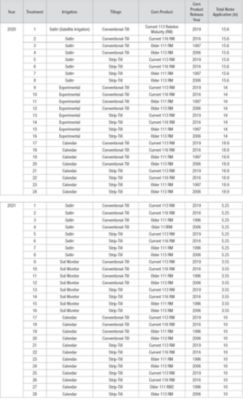
- The study was set up as a split-split plot with irrigation as the whole plot effect, tillage as the sub-plot effect, and corn product as the sub-sub plot effect. Each of the treatments was replicated three times in the trial.
- Table 1 lists all the treatments in 2020 and 2021.
- All treatments were planted in 30-inch rows.
- On 5/5/2020, 27.5 lb/acre N, 70 lb/acre P, and 15 lb/acre S was band applied in the conventional tillage blocks and strip till applied in the strip tillage blocks.
- On 5/5/2021, a base fertilizer application of 27 lb/acre N, 60 lb/acre P, 25 lb/acre S, 0.25 lb/acre Zn was band applied in the conventional tillage blocks and strip-till applied in the strip-tillage blocks.
- Additional Nitrogen was applied at 170 lb/acre in 2020 and 160 lb/acre in 2021. All nitrogen was applied at the V6 stage or earlier in both years.
- Force® 3G insecticide was applied at 5.5 lb/acre uniformly in furrow to control corn rootworm in both years.
- Irrigation was applied using a variable rate irrigation system on a linear move sprinkler.
- Irrigation Recommendations information was as follows:
- Satellite Irrigation – irrigation recommendations generated from the analysis of corn growth from satellite imagery using proprietary algorithms.
- Experimental – experimental irrigation recommendation strategy.
- Calendar – recommendation was done by watching local producer start and end dates for irrigation.
- Soil Monitoring - recommendation was based on field observations with a hand probe and WaterMark sensors.
- Plots were combine-harvested. Grain moisture content, test weight, and total weight were determined. Statistical analysis for Fisher’s LSD was performed.
In 2021, additional plot ratings at harvest were taken including stalk lodging and stalk intactness. Stalk lodging ratings were a visual score of how many stalks were broken over below the ear, and intactness was a visual score of the number of tassels still upright in the corn at harvest.
Understanding the Results
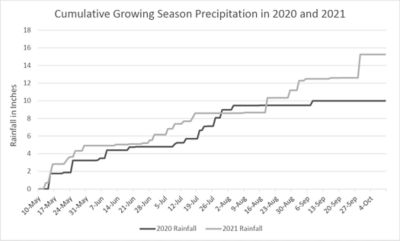
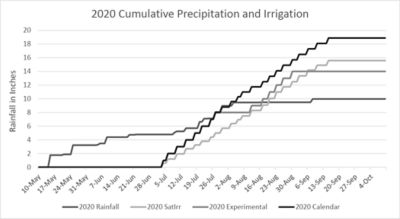
2020 and 2021 rainfall patterns were different in the total amount of rainfall that fell with 2020 showing about 10 inches of rainfall during the growing season and 2021 having 15.25 inches on the season (Figure 1). This reduced the irrigation applied in 2021 vs. 2020. Crop stress in 2020 occurred prior to corn tasseling and in the grain fill stage. In 2021, dry conditions from July 18th to August 18th during tassel and early grain fill caused severe crop stress.
The different irrigation strategies did recommend varying levels of applied irrigation water (Figure 2).
The calendar management strategy ended up at 18.9 inches on the season with consistent applications of water throughout the irrigation season from beginning to end.
The Satellite Irrigation strategy recommended 15.6 inches of water applied. It was consistent throughout the season, but lower rates of water were recommended and applied each week.
The lowest irrigation total was observed with the EXPERIMENTAL strategy that stopped irrigation earlier and accounted for rainfall in the late July timeframe as an opportunity to turn off the water for a few days.
No significant differences were seen in corn yields between the three irrigation strategies, indicating that all strategies were supplying adequate irrigation water.
Conventional tillage and no-tillage systems also had no impact on yield in 2020.
The current corn products yielded substantially more than the older products in this study, demonstrating the impact of continued genetic improvements in corn products now commercially available (Figure 3).
In economic terms, the advantage of modern corn products at a $5.00/bu amounts to about $420/unit of seed and $245/unit of seed when compared to the products released in 1997 and 2006, respectively.
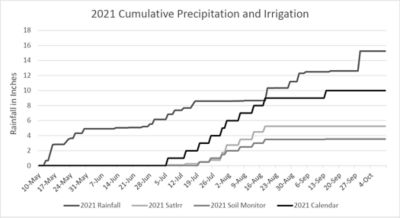
In 2021, the growing season rainfall was 5.25 inches higher than in 2020 (Figure 1 vs. Figure 4) and it resulted in lower application levels with the three irrigation strategies.
In 2021, the calendar management strategy was at 10.0 inches on the season with an earlier start to irrigation, more applied most weeks and a final 0.5” application late in the season (Figure 4).
The Satellite Irrigation strategy recommended 5.25 inches of irrigation. It was consistent throughout the season, but recommended less per week, and it did not recommend a final irrigation at the end of the season
The lowest irrigation total was observed with the soil monitor strategy that was similar to Satellite Irrigation but was just a little more conservative in the weekly recommendations. It ended with a total of 3.55 inches applied.
Despite the difference in irrigation amount, no difference was seen in corn yield or stalk lodging between the irrgation strategies.
One difference resulting from the irrigation treatment was improved plant intactness (Figure 5) with calendar management strategy, leading to better looking plants at harvest.
Tillage practice had no impact on corn yield in 2021 which was consistent with 2020.
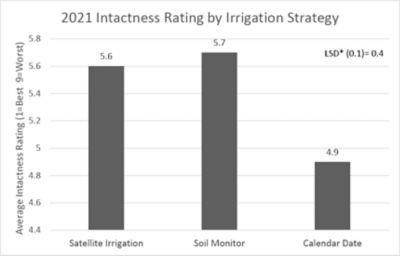
In 2021 corn products impacted both the stalk lodge rating and the corn yield.
The stalk lodge ratings were taken just prior to harvest on a scale of 1-9, with 1 being near zero stalk lodge and 9 representing nearly all the plants lodged below the ear.
It is notable that the modern 116RM product had a lower stalk lodge than the other products.
Corn product yield was highest in the current products. As in 2020, the Older 113RM and Older 111RM2 products were well behind modern products in yield in the field environment (Figure 3).
Again in 2021, there were no differences between the tillage treatments or the water application strategies, but unlike 2020, there were interactions that occurred between these factors and the corn products in terms of yield and stalk lodge.
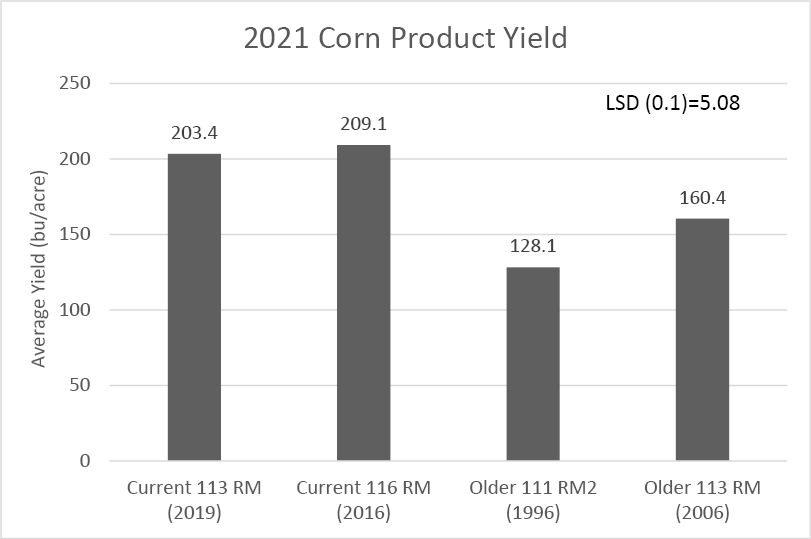
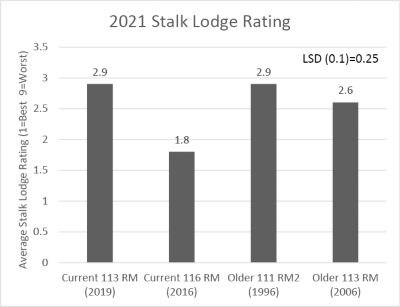

Similar to 2020, yield (Figure 6) was heavily correlated with the corn products being tested. The older 113RM and 111RM products had much lower yields relative to modern Current 113RM and 116RM products.
Corn was still standing well even with the late October harvest date. A rating of 1 indicates that near zero lodged plants were observed in the plot (Figure 7).
Intactness was impacted by the late harvest date. It does impact the harvest appearance of a field, but it has little effect on yield because the tassels or tops of the corn are gone above the ear. The best intactness rating was noted in the lowest yielding product (Figure 8).
Key Learnings
Irrigation strategy can have a large impact on the amount of water applied in a trial but adding more water through irrigation does not necessarily result in higher yields. There is a point where there is very little return for the water applied.
Using a strategy that did not rely on a calendarized starting date, followed by irrigation based on strategies with measurements of field data, saved water usage in 2020 and 2021.
Current products provided much higher yields in the trial compared to older products, demonstrating the economic advantage that today’s products have even with the same inputs supplied.
- This trial will continue in 2022.
1021_R9_21